Cape Verde Islands – Wind and Weather
People have a lot of preconceptions about what the weather is like in the Cape Verdes.
Now that the developers and holiday salesmen have put the islands on the map most land-lubbers imagine the islands to be hot and sunny. This is not actually the case. The weather here is almost always sunny – that much is true – but in the winter the sky is often hazy, and the almost-constant wind keeps the temperature down. Although they lie in the tropics, generally speaking the Cape Verdes are no warmer than the seaside areas of the Canary Islands.
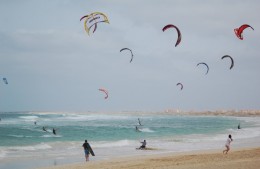
Yachtsmen, meanwhile, have the impression that the islands are very windy with a high incidence of gales. Some even believe that this area is prone to hurricanes.
As ever, there is a glimmer of truth in the legends; but no more than a glimmer.
Gale Force Winds
If you talk to the locals they will tell you that throughout January, February, and March the wind in their islands blows a non-stop north-easterly force six. They’re wrong, as it happens – land-lubbers are always wrong about the wind, even if it’s their own wind – but they’re on the right lines.
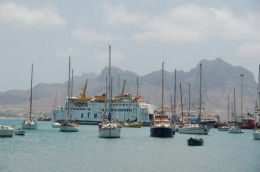
During the winter months the weather in this region is governed by the positions of the Azores High – which generally lies to seaward of the Canaries, at this time – and by the North African Low which hovers over Morocco. When these two systems sit close together the wind funnels between them blasting the archipelago with a steady force six north-easterly. However, when the systems wander apart, as they occasionally do even in January of February, then the wind can fade to a force three.
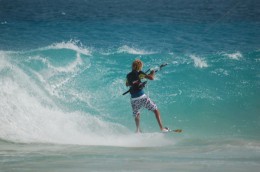
If you actually enjoy sailing then the thought of a force six will cause you no displeasure – on the contrary – but if you are a traveller, first and foremost, and the sort of person who regards the sea as something to be traversed in the quickest possible way, with the minimum of disorder to your floating caravan, then, indeed, you might want to give the Cape Verdes a miss. In particular you will want to avoid those parts of the archipelago where the super-strength tradewind receives a special boost; those places where the land is shaped in such a way as to suck the wind in and send it out again in with twice the vim and vigour.
These locations vary according to the exact direction of the wind – it has to strike the land at exactly the right angle for the turbo-charger effect to operate – but one of the most infamous acceleration zones is the channel between Sao Vicente and Santo Antao. Plenty of yachts have spent longer than they intended in Mindelo (Sao Vicente) having scared themselves silly during their arrival, and plenty have torn their sails in this strait. If the wind is blowing a steady force six north-easterly on the open water then it is probably blowing at gale force here.
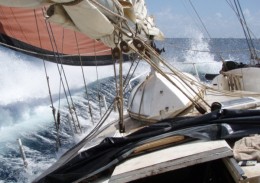
Two other even more spectacular acceleration zones are Sao Pedro, on the south coast of Sao Vicente, and the south-west coast of Sao Nicolau. Sao Pedro is the place where the world speed sailing record was first lifted to 40 knots; and in Tarrafal, Sao Nicolau we have seen the tradewind pumped up to such an extent that our Avon rubber dinghy was turning barrel rolls on the end of its painter.
The south coast of Fogo can also be pretty exciting – we’ve known it to blow at gale force here while the true wind, on either side of the island, was only force two – and the sea off the most western point of Brava often dances wildly at the piping of another local devil whilst the area adjacent lies as calm as the village pond.
Finally, the taller islands are all capable of kicking up some dramatic williwaws.
Hurricanes
As for hurricanes: yes, the cyclone-systems often form here – and when they do they are known as Cape Verde hurricanes – but fledgling hurricanes are about as deadly as newborn alligators. The tropical waves pick up steam as they travel westward towards the Caribbean.
Just about the worst that can happen here in Cape Verde, in the way of unkind weather, is a strong southerly gale associated with a tropical wave; and even in the summer you won’t get that very often.
In the course of five visits to the islands, including two summers, we have never experienced a southerly stronger than a force three. However, bad weather is certainly a possibility at that time of year, and in the summer of 2010 there was a force 9 gale.
Bad Vis
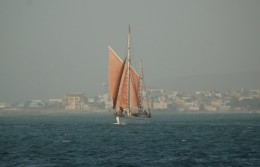
The most dangerous aspect to the weather in the Cape Verdes is probably the “bruma seca” or dry fog. This phenomenon occurs regularly between December and April when the north-easterly trades sweep over the great desert wastelands of Morocco and Mauritania picking up a fine brown dust. In Africa it is known as the harmattan.
If you look up you won’t see the dust – the sun will continue to shine and the sky will be blue – but as you draw south towards the islands you will notice that the horizon has become fuzzy. If there are any ships around then they will seem to creep up on you, suddenly appearing from nowhere; and even when they are only a mile or two away they may be nothing more than hazy grey shapes.
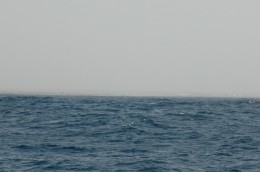
As you approach the islands you will start to keep a better look-out, searching the horizon for your destination, and when the GPS puts you just ten miles away then you will begin to wonder what the heck is going on…
If the strange, invisible “fog” is really thick then the visibility might be reduced to just one mile, and in these conditions the first thing that you see might be the white breakers on the windward shore of the island.
If it’s Maio that you’re approaching then you will have hit the reefs before you are one mile from the land… so do keep a really good look-out. And don’t rely too heavily on the satelites. They will give you your correct position – no doubt of it – but unfortunately the islands don’t lie exactly where they were charted.
If you enjoy sailing then, as I say, none of this should put you off – but if you like an easy life then the Cape Verde archipelago is probably not the place for you to be playing.
For more information about the Cape Verde islands, take a look at our other recent articles about the archipelago:
- General info:
- Sal
- São Vicente
- Boa Vista
